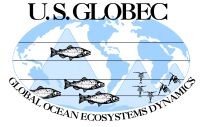
Participants
__________
GLOBEC
International
__________
| GLOBEC Northeast Pacific Program Mapping of Physical and Biological Fields in the Northern California Current July 31 - August 19, 2002 |
 |
August 12, 2002 SeaSoar and station work on the South fine scale survey 8:00 a.m.: Another clear day for the Revelle which is continuing the fine scale survey. Later today the remaining drifters will be deployed and some station work will take place. Amanda Briggs works on preparing the bio-optical profiler package. 11:00 a.m.: Station work begins. The first task was the release of the three remaining drifters. The drifter assembly consists of a large beach ball-sized sphere that contains the optical sensors, GPS receiver, and ARGOS transmitter. The sphere is attached by a long cable to a long tube made of a black mesh fabric material that hangs several meters down below the surface. The purpose of the mesh fabric tube is to cause the drifter to move with the water currents several meters down rather than being blown by the wind across the surface. Shown below launching the drifter are Amanda Ashe, Renato Castelao, and Guido Corno. After the drifters were released, the TSRB was deployed for 25 minutes. Guido Corno is shown monitoring the tether. The next item to go over the side was the bio-optical profiler package. As before, it is lowered on a cable and stays in the water for close to two hours. It is lowered slowly and every few meters it is halted so detailed readings can be made. Amanda Briggs and Chris Wingard are shown below.
Chief Scientist Report for 12 August 2002 3:00 p.m.: The CTD/rosette was recovered as the last item at this station. Whenever an instrument on a cable is deployed or recovered over the side of the ship, "tag lines" are used to control the swinging motion of the instrument. Tag lines are ropes that are held tight by two crew people under the direction of the resident technician and are vital under rough conditions to prevent damage to the instrument or injuries to the crew. Shown below Chris Wingard and Mauricio Andrades use tag lines during a CTD/rosette recovery under the direction of resident technician Tami Baiz. Assisting is Cidney Howard.
|
This page was last updated on August 13, 2002 07:46 AM
.jpg)
.jpg)
.jpg)
.jpg)
.jpg)
.jpg)
.jpg)
.jpg)
.jpg)
.jpg)
.jpg)
.jpg)
.jpg)
.jpg)
.jpg)
.jpg)
.jpg)
.jpg)


